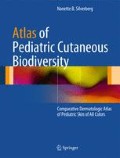Abstract
With the rising incidence of obesity in the United States, nearly a third of US inhabitants will be at high risk for the metabolic syndrome. The metabolic syndrome is a combination of obesity, cardiovascular risk factors including elevated cholesterol and triglycerides, and diabetes mellitus. This article reviews briefly the features of the metabolic syndrome. Obesity (elevated BMI) and acanthosis nigricans should prompt evaluation for insulin resistance, irrespective of race.
Access this chapter
Tax calculation will be finalised at checkout
Purchases are for personal use only
References
Aswani R, Lochow A, Dementieva Y, Lund VA, Elitsur Y (2011) Acanthosis nigricans as a clinical marker to detect insulin resistance in caucasian children from West Virginia. Clin Pediatr (Phila) 50(11):1057–1061
Nguyen TT, Keil MF, Russell DL, Pathomvanich A, Uwaifo GI, Sebring NG, Reynolds JC, Yanovski JA (2001) Relation of acanthosis nigricans to hyperinsulinemia and insulin sensitivity in overweight African American and white children. J Pediatr 138(4):474–480
Stuart CA, Pate CJ, Peters EJ (1989) Prevalence of acanthosis nigricans in an unselected population. Am J Med 87(3):269–272
Sherry N, Hassoun A, Oberfield SE, Manibo AM, Chin D, Balachandar S, Pierorazio P, Levine LS, Fennoy I (2005) Clinical and metabolic characteristics of an obese, Dominican, pediatric population. J Pediatr Endocrinol Metab 18(11):1063–1071
Shipman AR, Millington GW (2011) Obesity and the skin. Br J Dermatol 165:743–750
Silverberg JI, Kleiman E, Lev-Tov H, Silverberg NB, Durkin HG, Joks R, Smith-Norowitz TA (2011) Association between obesity and atopic dermatitis in childhood: a case-control study. J Allergy Clin Immunol 127:1180–1186
Mathur AN, Goebel L (2011) Skin findings associated with obesity. Adolesc Med State Art Rev 22:146–156, ix
Author information
Authors and Affiliations
Rights and permissions
Copyright information
© 2012 Springer Science+Business Media, LLC
About this chapter
Cite this chapter
Silverberg, N.B., Silverberg, N.B. (2012). Metabolic Syndrome. In: Atlas of Pediatric Cutaneous Biodiversity. Springer, New York, NY. https://doi.org/10.1007/978-1-4614-3564-8_14
Download citation
DOI: https://doi.org/10.1007/978-1-4614-3564-8_14
Published:
Publisher Name: Springer, New York, NY
Print ISBN: 978-1-4614-3563-1
Online ISBN: 978-1-4614-3564-8
eBook Packages: MedicineMedicine (R0)

